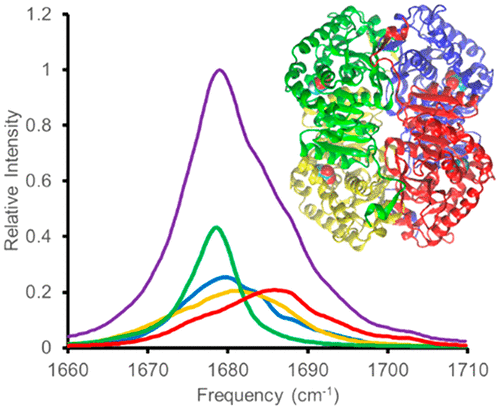Yin, H.; Li, H.; Grofe, A.; Gao, J.. ACS Catalysis, 2019, 9, 4236-4246.
Molecular dynamics simulation of human heart lactate dehydrogenase (LDH) has been carried out to determine the linear and two-dimensional Fourier transform infrared (2D-FTIR) spectra for the carbonyl stretch vibration of pyruvate in the tetrameric enzyme, using quantum vibrational perturbation theory. The computed line-shapes of individual subunits are inhomogeneously broadened and span the entire absorption range of the carbonyl vibration of the full enzyme, indicating the similar conformation heterogeneity in the four active sites of LDH. However, each subunit line-shape has different width and peak maximum due to variations in conformation equilibrium in different subunits, corresponding to the spectral multiplets observed experimentally. Since there is a finite time interval before a substrate is converted into products in a given active site, the distribution of such a time coarse-grained average of Michaelis complexes is called active-site heterogeneity. Active-site heterogeneity is distinguished from conformation heterogeneity in that, although the former is governed by the same energy landscape that gives rise to conformation heterogeneity, a stochastic enzyme–substrate adduct can only sample a fraction of the conformation space, limited by the enzyme turnover and shown as a distribution of waiting times, i.e., reaction rates, in single-enzyme experiments. The present study showed that different absorption peaks in the C═O stretch region of the Michaelis complex, observed experimentally and reproduced computationally, are due to active-site heterogeneity, as a superposition of the spectral line-shapes of different active sites. Consequently, substates corresponding to these spectral peaks of LDH do not interconvert and they have different reaction rates, as found experimentally. The present active-site heterogeneity mechanism is in complete agreement with the kinetic model derived from isotope-edited infrared and temperature-jump relaxation spectroscopy.

